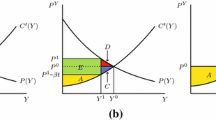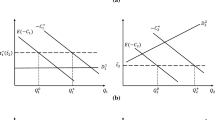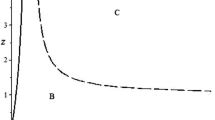Abstract
This paper compares a firm’s short run optimal production and abatement rules under emission level standards and standards expressed in terms of emissions per unit of output (ratio standards). The models allow for non-compliance with standards, with expected penalties dependant on either level or relative violations of the standard in question. It is shown that ratio arguments make a difference to the optimal decision rules derived for a profit-maximising firm. For example, for a given level of emissions the firm both produces more, and abates more, under a ratio standard, so that ratio and level standards cannot be used interchangeably to achieve the same combination of emissions and output. The implications for the efficiency of pollution control are briefly discussed.

Similar content being viewed by others
Notes
A firm’s expectations are key here. Expected penalties may be a function of relative violations even if the regulator’s design of the penalty structure is based upon nominal violations.
Note that, as a result, in an industry of heterogeneous firms, each firm’s marginal costs of reducing its pollution to output ratio are not equalised.
It is assumed that additional inputs are required for pollution abatement, i.e., inputs which would not otherwise be employed in the production process. The firm’s short run costs, therefore, are assumed to be separable in production of the good/pollutant and in pollution abatement. Note that the abatement cost function here differs from that of Harford (1984) and McKitrick (2001) who model abatement costs as a direct function of the firm’s pollution to output ratio.
The components of the expected penalty P(·) are the (subjective) probability of detection ϕ(·) (dependant upon the size of the violation as well as the enforcement parameters of the regulatory regime) and a monetary fine F(·) incurred if detected, so that P(·)≡ ϕ (·) F(·).
This is readily affirmed by replacing the expected penalty term in the Lagrangian function with a constraint term and then solving the first-order conditions for the appropriate Lagrange multiplier.
The alternative explanation, that we have B′(q*) and C′(a*) for the non-compliant firm both proportionately greater, can be ruled out immediately, since this would imply that the non-compliant firm is producing less, and abating more, than a compliant firm, which is nonsense.
Note that the same result is obtained if expected penalties depend upon the violation “level” expressed in ratio units, i.e., e/q – R
This is true as long as the nominal cost of a percentage reduction in emissions per unit of output is increasing in output, which will generally be the case
References
Beavis B, Walker M (1983) Random wastes, imperfect monitoring and environmental quality. J Public Econ 21(3):377–387
Downing PB, Watson WD (1974) The economics of enforcing air pollution controls. J Environ Econ Manage 1(3):219–236
Ebert U (1998) Relative standards: a positive and normative analysis. J Econ 67(1):17–38
van Egteren H, Weber M (1996) Marketable permits, market power and cheating. J Environ Econ Manage 30(2):161–173
Harford JD (1978) Firm behavior under imperfectly enforceable pollution standards. J Environ Econ Manage 5(1):26–43
Harford JD (1984) Relatively efficient pollution standards under perfect competition. Public Finan Q 12(2):183–195
Harford JD, Karp G (1983) The effects and efficiencies of different pollution standards. East Econ J 9(2):79–89
Harford JD, Ogura S (1983) Pollution taxes and standards: a continuum of quasi-optimal solutions. J Environ Econ Manage 10(1):1–17
Hatcher A (2005) Non-compliance and the quota price in an ITQ fishery. J Environ Econ Manage 49(3):427–436
Helfand G (1991) Standards versus standards: the effects of different pollution restrictions. Am Econ Rev 81(3):622–634
Hochman E, Zilberman D (1978) Examination of environmental policies using production and pollution microparameter distributions. Econometrica 46(4):739–760
Keeler AG (1991) Noncompliant firms in transferable discharge permit markets: some extensions. J Environ Econ Manage 21(2):180–189
McKitrick R (2001) The design of regulations expressed as ratios or percentage quotas. J Regul Econ 19(3):295–305
Malik A (1990) Markets for pollution control when firms are noncompliant. J Environ Econ Manage 18(2):97–106
Malik A (2002) Further results on permit markets with market power and cheating. J Environ Econ Manage 44(3):371–390
Acknowledgements
I would like to thank two anonymous reviewers whose challenging comments and helpful suggestions aided considerably the preparation of the final version of the paper.
Author information
Authors and Affiliations
Corresponding author
Rights and permissions
About this article
Cite this article
Hatcher, A. Firm behaviour under pollution ratio standards with non-compliance. Environ Resource Econ 38, 89–98 (2007). https://doi.org/10.1007/s10640-006-9063-6
Received:
Accepted:
Published:
Issue Date:
DOI: https://doi.org/10.1007/s10640-006-9063-6




